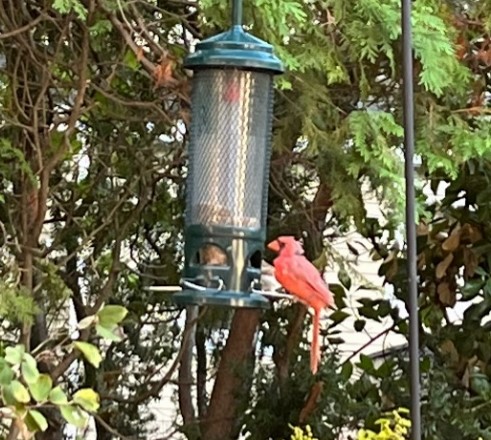
Synanthropic species (also called synanthropes) are animals that live in close proximity to people, benefit from the environments we create, but (unlike domesticated species) are beyond our control. Examples include common urban wildlife such as squirrels, rabbits, and robins (a forest bird that has adapted to a range of human-modified habitats). Larger animals, such as fox, deer, and coyote, have also adapted to suburban and urban landscapes. Some synanthropic species are native, others non-native (including perhaps the most notorious of all, the Norway rat), but all share a common attribute: they survive and thrive in urban ecosystems.
Synanthropic species evoke mixed emotions in people. We are annoyed and even angered by their incursions into our territory: squirrels raiding bird feeders, rabbits nibbling vegetable plants, raccoons ransacking garbage cans, and the like. As surrogates for “wilder” animals rarely if ever encountered in person, they stimulate biophilia – an innate sense of connection to nature – as seen in the seemingly irresistible appeal of feeding birds and other common wildlife. They can also induce more visceral emotions (fear of disease, physical injury, abduction of household pets, or worse) that are rooted in history, collective memory, and mythology.
From an ecosystem perspective, synanthropic species can have both negative and positive impacts. A well-known negative example is the proliferation of white-tailed deer in the eastern U.S. due to the lack of natural predators, which has had destructive effects on native forest diversity and regeneration. On the positive side, bats consume vast numbers of mosquitoes and other insects; birds and other animals disperse seeds; and raccoons are important links in the food chain, to name just a few examples.
Most often we take synanthropic species for granted, deeming them less worthy of attention than more compelling species such as forest-interior songbirds and so-called charismatic megafauna (e.g., polar bears). Governmental agencies and non-governmental organizations deservedly dedicate considerable resources to protecting and restoring natural areas and the native species that inhabit them, but none to my knowledge have taken up the cause of conserving common urban wildlife. Given pressing global challenges such as climate change, resource depletion, and rapidly diminishing biodiversity, how can synanthropic species possibly be important to the future of the planet?
Two Environmental Worldviews
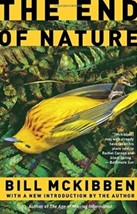
Before attempting to answer that question, let’s briefly consider worldviews developed by two contemporary environmental thinkers: Bill McKibben and Emma Marris. In his seminal book The End of Nature (first published in 1989), McKibben proclaimed that the idea of nature as a force independent of human influence had been extinguished by global warming: “We have built a greenhouse, a human creation, where once bloomed a sweet and wild garden.” He subsequently became a leading climate and justice advocate and helped found 350.org, a movement dedicated to bringing about a fossil-fuel world.
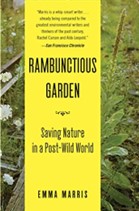
In Rambunctious Garden: Saving Nature in a Post-Wild World (2011), Emma Marris agrees with McKibben that pristine nature no longer exists and that it is impossible to recreate it: “We have stirred the global pot, moved species around, turned up the thermometer, domesticated a handful of plants and animals, and driven extinct many more.” Because human actions have irrevocably altered the planet, we are now obliged to serve as responsible stewards of the resulting “rambunctious garden.” Implicit in Marris’ thinking is the emerging paradigm of reconciliation ecology (a term coined by ecologist Michael Rosenzweig), which seeks to proactively share human habitats with other species.
So, how do synanthropic species fit with these two worldviews? McKibben might characterize them as evidence of the diminishment of wild nature – semi-domesticated species that have adapted to the greenhouse we have created. Marris, on the other hand, might see them as an opportunity to evolve a “new nature” in which humans and other living species can thrive together. They would undoubtedly agree on the need to reverse the course of climate change, habitat destruction, and species extinction caused by human actions. They might also agree that a world in which humans, synanthropes, and wilder species co-exist is a worthy goal for the future.
A Prescription for Nature
As I write these words in the wake of an unrelenting summer heat wave that gripped much of the northern hemisphere, it is clear that nature is sick and needs healing. Extended periods of severe heat and drought, catastrophic wildfires, and unprecedented flooding are all symptoms of a planetary health crisis that is the consequence of human endeavor. Treating these symptoms will require addressing their root causes, including fossil fuel emissions and natural habitat destruction. Similar to park prescriptions that encourage people to spend time in nature to improve their wellbeing, a dual prescription is urgently needed to restore nature to a state of health. First, bring down the planetary fever by reducing carbon levels in the atmosphere. Second, implement a three-pronged approach to stabilize and reverse the degradation of natural ecosystems:
- Undertake large landscape-scale initiatives to conserve, expand, and connect remaining wilderness areas (rewilding).
- Restore natural ecosystems (plants, animals, soils, and water) that have been damaged or destroyed by human activities (ecological restoration).
- Integrate nature into the environments in which people live, work, learn, play, and move through the landscape (green infrastructure).
The envisioned outcome is a green network that encompasses wilderness areas for animals requiring the most territory (e.g., keystone species like the grizzly bear and gray wolf); large habitat hubs and corridors supporting native plant and animal communities; and suburban and urban landscapes, the primary habitat of people and synanthropic species. The two halves of the prescription are complementary: trees and other vegetation comprising the network will remove carbon from the atmosphere, while removing carbon will mitigate climate change impacts such as severe heat and drought on natural communities.
Let’s look more closely at how nature can be integrated into suburban and urban landscapes. Communities across the nation are using green infrastructure to manage stormwater and, more broadly, to create systems of parks, natural areas, and other open spaces that provide a host of ecosystem services and benefits for people. Examples range from site-scale applications like rain gardens, green roofs, and constructed wetlands to greenway corridors and the urban tree canopy at the communitywide scale. By incorporating native plantings and features such as biodiverse, pollinator-friendly green roofs, green infrastructure can be designed to provide a suitable environment for insects, birds, and other inhabitants of a healthy natural ecosystem.
In Rambunctious Garden, Emma Marris describes two emerging ecological concepts that can be applied to developing the green network in urban and suburban landscapes. Novel ecosystems are new, human-influenced combinations of species that are found in remnant natural areas, untended yards, vacant lots, and other disturbed spaces that are ubiquitous in these landscapes. According to Marris, novel ecosystems “can function as well or better than native ecosystems and provide for humans with ecosystem services of various kinds – from water filtration and carbon sequestration to habitat for rare species.” Designer ecosystems, on the other hand, are intentionally created to achieve specific goals, such as stormwater management or climate amelioration. Rain gardens and other green infrastructure installations are well-known examples. “Mini-forests,” in which native trees and shrubs are planted on small plots of land using methods developed by Japanese ecologist Akira Miyawaki, are another. Also called tiny forests, mini-forests are being established across the globe, in countries like Japan, India, Iran, France, the Netherlands, and the United States.
In Synanthropic Suburbia (a Master of Architecture thesis for the University of Waterloo, Ontario), Sarah Gunawan proposed a series of design interventions in suburban landscapes to nurture positive relationships between people and synanthropes. At the scale of the single-family lot, she developed three architectural prototypes (“synanthropic prosthetics”) that could be incorporated into typical suburban houses to “maximize the mutual benefits of cohabitation.” These prototypes (called the Compost Chimney, Extended Eave, and Habitat Dormer) were designed to meet the habitat requirements of brown bats, Eastern bluebirds, racoons, and three other target species. At the landscape scale, Gunawan proposed a system of vegetated corridors and connectors along rear and side property lines, providing a continuous animal movement system as part of the suburban landscape matrix.
A Tale of Two Synanthropic Species
I live on the outskirts of Narberth, Pennsylvania, a small borough northwest of Philadelphia. This past winter we replaced the garage attached to our 1930s-era house with a sunroom and the adjoining driveway with a stone patio and planting area. As the contractors were finishing their work in the spring, a Carolina wren began building a nest in a recess they had created to accommodate an outdoor light fixture. I felt a slight pang of guilt when the electrician unceremoniously removed the nest to install the light. This feeling was assuaged when, soon thereafter, the wren began building a new nest in a hose reel we had attached to the exterior wall of the sunroom.
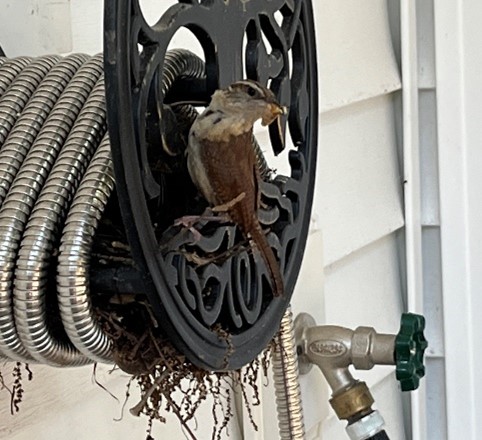
For the rest of the spring and into the summer, we shared our new patio with a family of wrens. Seated in a chair a few feet away, I watched the wren and its mate travel to and from the hose reel to complete their nest, tend to their eggs, and feed insects to their nestlings after they hatched. I became quite accustomed to their presence – and they tolerated mine – until one morning the wrens were gone, having moved on after raising their brood.
Wrens are, of course, an example of a synanthropic species. They nest in tree cavities, natural crevices, and the many nooks and crannies created by humans, which are preferred nesting sites in suburban landscapes. While small (weighing about as much as two quarters), they are aggressive birds known to defend their territory by removing eggs from nests of other species. In retrospect, it is easy to understand why the wrens picked my hose reel (which Sarah Gunawan might call an unintentional form of synanthropic prosthetics) as a nesting site. It is sized perfectly for a nest; its location above the patio and sheltered by the sunroom provides protection from the weather and predators; nearby trees, shrubs, and a weedy lawn provide cover and an abundant food source; and the male can survey its territory from the peak of our neighbor’s garage.
One early morning in June, I glanced out the sunroom window and was surprised to see a red fox a mere 20 feet away, trotting along the top of a low stone wall that marks our side property line. Fascinated, I watched it enter the back yard, pause for a moment in the shelter of a holly hedge, and continue onto the lawn. I may have moved, because the fox seemingly became aware of my presence, turned, and disappeared into the shrubbery along the rear property line. A few weeks later, I again saw the fox, this time moving from the patio to the back yard carrying prey in its mouth.
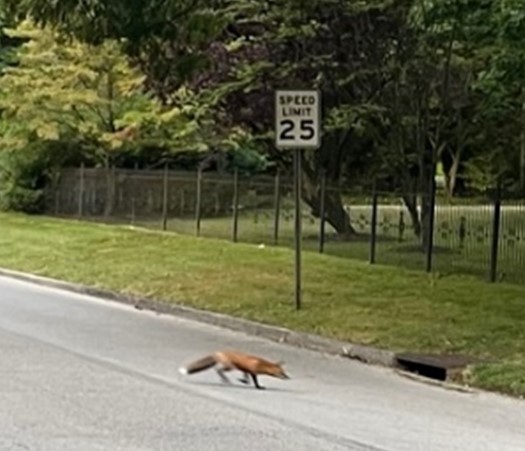
What explains the appearance of a red fox, an animal we more commonly associate with pastoral landscapes, in a small yard in a developed community like Narberth? Like many synanthropes, foxes are an edge species native to mixed forest, brush, and grassland habitats, which suburban environments resemble. They consume rodents, rabbits, insects, earthworms, and other animals (as well as fruits and vegetables) that are abundant in human-modified landscapes. Other habitat requirements include a den site (for example, dense brush, hollow logs, or spaces under sheds) and access to water. All of these necessities of life are available within a mile or two of my house – the typical size (more or less) of an urban-dwelling red fox’s territory.
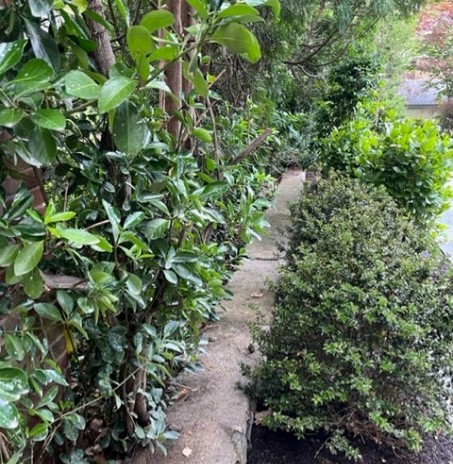
Foxes are known to frequent the back yard of the house across the street. I sometimes saw them on the opposite sidewalk in 2020 during the pandemic-induced lockdown; on one occasion a fox ventured partway down my driveway while I was working on a ladder on the side of the house. Two years later, by removing and replanting part of the driveway, I created a vegetated corridor along the side property line that a fox used to access more extensive vegetation in the back yard. This recalls Gunawan’s proposal to create a continuous animal movement system as part of the suburban landscape matrix.
The Future
Dating back to Aldo Leopold, who founded the first wildlife ecology program at the University of Wisconsin-Madison in the 1930s, the traditional focus of wildlife ecologists has been on species in natural settings. Only in the last several decades has urban wildlife research (i.e., the study of synanthropic species) emerged as a distinct discipline, paralleling the emergence of urban ecology – the study of the interactions between human and natural systems in cities – as a field separate from ecology. This evolution mirrors the progression from the predominant environmental paradigm of the 20th century – nature as something separate and needing protection from humans – to an emerging 21st century one: nature as something to be integrated with the built environment. These two paradigms in turn evoke the worldviews of Bill McKibben and Emma Marris. McKibben mourned the end of pristine nature at the hands of humans and then committed to action to address our impacts. Marris acknowledges these impacts and calls on us to become responsible stewards of the resulting ecosystems.
I believe that both worldviews are essential to achieving a sustainable future. Changing course will not be easy; to the contrary, it may be the hardest thing humans as a species have ever had to do. It will require a commitment to eliminate carbon emissions and halt the destruction of natural ecosystems. It will also require embracing a new role as responsible stewards of the green network – a web of life that envelopes the land from wilderness areas to rural, suburban, and urban landscapes. The goal is a world in which humans, urban wildlife, and wilder species co-exist and mutually benefit from the services provided by nature.
Synanthropic species are important to our future because their health – like the proverbial canary in the coal mine (a saying from our fossil-fuel dependent past) – is an indicator of the health of urban ecosystems and, in a world where everything is connected, the health of the planet as whole. They contribute valuable ecosystem services; squirrels and blue jays, for example, help propagate that most stalwart of native trees, the oak. A healthy ecosystem is diverse, resilient to disturbance, and maintains a sustainable balance among its constituent parts. An unhealthy ecosystem is homogenous, easily changed by disturbance, and unbalanced (for example, a monoculture or one dominated by invasive species). If our current trajectory continues, the latter will be the ecologically impoverished legacy of the Anthropocene era. We need to change that trajectory if we hope to ensure a sustainable future for the planet, people, and the species we share the planet with.
Photos by the author
References
Gunawan, Sarah. Synanthropic Suburbia. Master of Architecture Thesis. Waterloo, Ontario: University of Waterloo, 2015.
Magle, Seth B., Victoria M. Hunt, Marian Vernon, and Kevin R. Crooks. “Urban wildlife research: Past, present, and future,” Biological Conservation 155 (2012) 23-32.
Marris, Emma. Rambunctious Garden: Saving Nature in a Post-Wild World. New York: Bloomsbury, 2011.
McKibben, Bill. The End of Nature. New York: Random House, 1989.
Rosenzweig, Michael L. Win-Win Ecology: How the Earth’s Species Can Survive in the Midst of Human Enterprise. Oxford: Oxford University Press, 2003.
